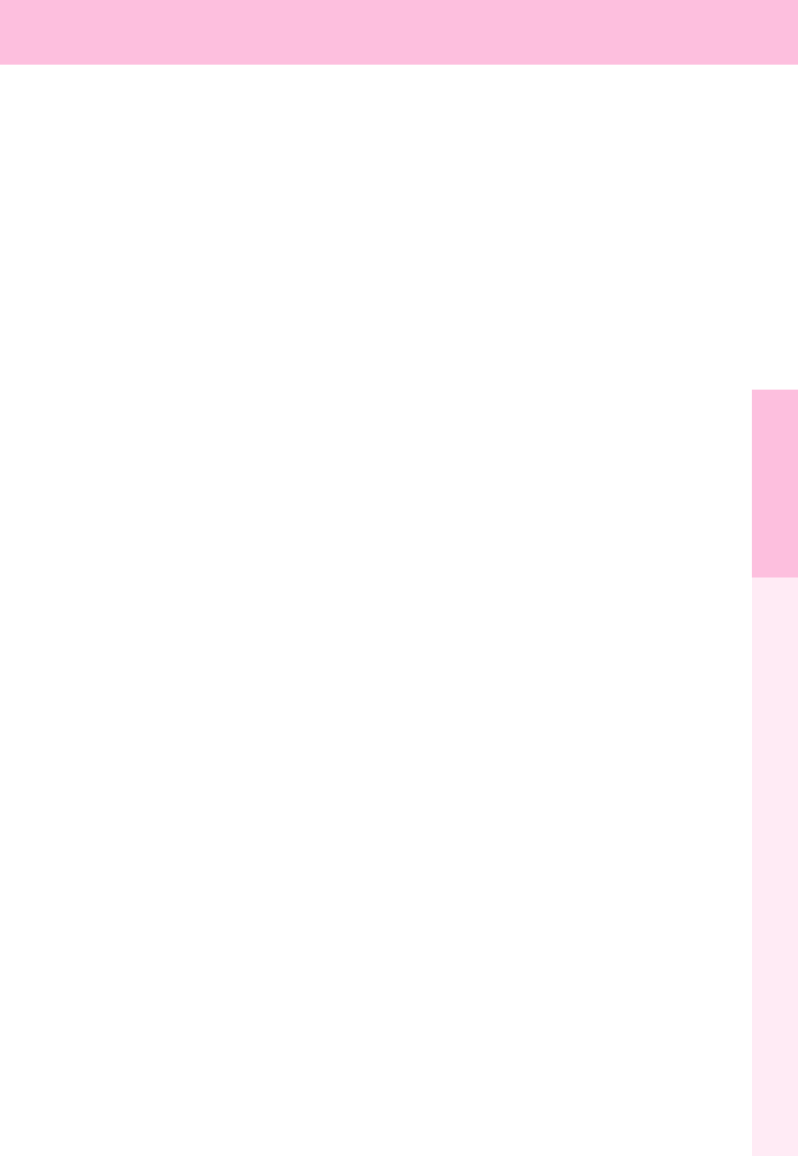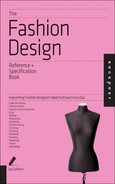
Job:02-30034 Title:RP-Fashion Design Ref and Spec Book
#175 Dtp:225 Page:126
116-129_30034.indd 126 2/27/13 4:41 PM
12 6 THE FASHION DESIGN REFERENCE + SPECIFICATION BOOK
(Text)
PRINTING
The printing process uses pigments and dyes to form patterns on fabric. With the exception
of roller printing, these techniques can be employed on a small scale for cottage industries
or in mass production with machines. Hand-painted fabrics aside, a printed fabric is designed
using a motif as a structured repeat. The repeat is a nite block of a pattern that is duplicated
and distributed over a surface to create the allover print. Designing prints with repeats can
be compared to brickwork: Each brick is laid next the previous one, so that the end of one
connects with the beginning of the next. The next level of repeats can line up with the lower
one or it can shift over to randomize the pattern. In textile printing, this design technique is
called a drop-repeat or a brick repeat and it can be applied both horizontally and vertically. It is
important for the design on each panel or section to interlock with the next one, to create the
illusion of a seamless pattern.
Common Printing Methods
Hand Block Printing: Blocks of wood are etched with a pattern that is designed to interlock.
The block is dipped in the desired color and applied directly to the fabric. The next impression
will line up with the last one to achieve the effect that the pattern is continuous. To create
more complex designs, the process can be repeated with different colors and block patterns
that overlap and interlock with the previous pattern.
Roller Printing: Fabric is passed through engraved pressure cylinders that have been inked.
Contemporary machines are synchronized to be able to produce detailed prints with multiple
colors. Also called cylinder and machine printing.
Screen Printing: An ink-blocking emulsion is applied to a framed, nely woven mesh in the
desired pattern. A squeegee or roller pushes pigment through the unblocked areas, effectively
transferring a clear pattern onto the fabric. As with hand blocking, the process can be repeat-
ed with new overlapping and interlocking patterns in other colors to create more complexity.
Heat Transfer: Heat and pressure are used to transfer ink on carrier paper onto fabric. In some
instances the ink permeates the fabric, while in others the design adheres to the surface.
Computer printers and copiers can now print onto carrier paper for iron-on transfers.
Stencil: Cutouts provide the boundaries for painting repeats of a pattern. New stencil patterns
and more colors can be overlaid on the rst pattern.
Digital Textile Printing: Modi ed ink-jet technology is used for printing colorants onto fabric—
either printing smaller designs onto garments DTG, (direct to garment) or for printing larger
designs onto large-format rolls of fabric.
S
C
A
B
E
E
F
a
th
R
S
se
B
To
m
fa
go
is
Photograph by Christelle/Fotolia.
11
Job:02-30034 Title:RP-Fashion Design Ref and Spec Book
#175 Dtp:225 Page:126
116-129_30034.indd 126 2/27/13 4:40 PM

Job:02-30034 Title:RP-Fashion Design Ref and Spec Book
#175 Dtp:225 Page:127
Book
e:126
116-129_30034.indd 127 2/27/13 4:41 PM
Textiles 12 7
(Text)
d
d
s
n
y
e
s
SURFACE ORNAMENTATION
Common Embellishments
Appliqué: Fabric cutouts applied for decoration
Beading: Bead embellishment used to create designs
Embossing: Raised design engraved on fabrics using heated rollers and pressure
Embroidery: Thread stitch embellishment used to create designs
Faggoting: Pattern produced by removing weft threads from a section of fabric, while the warp
threads are tied in bunches
Rhinestones: Lustrous imitation stones made of glass, paste, or gem quartz
Sequins: Disk-shaped beads, also called spangles or diamantes. (A larger version of the
sequin is called a paillette.)
Burn-Out
To simulate brocade or eyelet patterns, the burn-out process applies chemicals (most com-
monly sulfuric acid) to fabric, destroying the bers they come into contact with. Often the
fabric is then overprinted to create the desired effect. Velvet fabrics woven of ber blends are
good candidates for this procedure, because the burn-out chemical only destroys the pile, if it
is a cellulose ber, leaving the synthetic ground intact.
Sequins, Beads, and Feathers
Photograph by Christelle/Fotolia.
11
Job:02-30034 Title:RP-Fashion Design Ref and Spec Book
#175 Dtp:225 Page:127
Book
e:126
116-129_30034.indd 127 2/27/13 4:40 PM

Job:02-30034 Title:RP-Fashion Design Ref and Spec Book
#175 Dtp:225 Page:128
116-129_30034.indd 128 2/27/13 4:41 PM
12 8 THE FASHION DESIGN REFERENCE + SPECIFICATION BOOK
(Text)
U
FI
M
Ac
Ac
A
A
n
B
C
C
D
E
g
H
H
I
n
Ju
Le
L
i
M
M
M
O
P
i
R
R
R
R
S
S
V
V
W
K
B
C
C
Photograph by Joe Schmelzer/Getty Images.
A
fo
of
is
it
T
e
a
se
F
11
Job:02-30034 Title:RP-Fashion Design Ref and Spec Book
#175 Dtp:225 Page:128
116-129_30034.indd 128 2/27/13 4:40 PM

Job:02-30034 Title:RP-Fashion Design Ref and Spec Book
#175 Dtp:225 Page:129
Book
e:128
116-129_30034.indd 129 2/27/13 4:41 PM
Textiles 12 9
(Text)
UNDERSTANDING TEXTILES
FIBERS/
MATERIALS:
Acetate
Acrylic
Alpaca
Angora
Bamboo
Camel Hair
Cashmere
Delaine Wool
Egyptian Cotton
Heathered Wool
Hemp
Indian Cotton
Jute
Leather/
Leatherette
Linen
Merino wool
Micro ber
Mohair
Ole n
Pineapple Fiber
Raw Silk
Ramie
Rayon
Rubber
Sherpa
Spandex
Vinyl
Viscose
Worsted Wool
KNIT TYPES:
Bouclé
Chenille
Cotton Stretch
Jersey
Cotton Jersey
Double Knit
Faux Fur
Fair Isle Knit
French Terry
Heather knit
Handknit
Intarsia
Interlock
Jacquard knit
Jersey
Jumbo stretch
Matte Jersey
Mesh
Raschel Print
Rib Knit
2 -way Stretch
4-way Stretch
Polar Fleece
Shaker Knit
Slinky
Stockinette
Stretch Knit
Velvet
Terry Velour
Tricot
Variegated
Weft Knit
Yarn-dyed Stripe
WEAVE
PATTERNS:
Bedford Cord
Bird’s Eye
Burnout
Canvas
Cavalry Twill
Damask
Donegal Tweed
Dotted Swiss
Duck
Eyelet
Flocking
Grosgrain
Gingham
Herringbone
Honeycomb
Houndstooth
Jacquard
Madras
Matelassé
Moiré
Ottoman
Oxford
Pointelle
Pique
Rip Stop
Seersucker
Tapestry
Terry cloth
Tartan
Tweed
Twill
Whipcord
Pinstripe
WOVEN
QUALITIES:
Batiste
Bouclé
Broadcloth
Brocade
Burlap
Cabric
Chambray
Canvas
Challis
Chantilly Lace
Charmeuse
Cheese Cloth
Chenille
Chiffon
Chintz
Corduroy
Crepe
Crepe-backed
Satin
Crinkle Gauze
Crepe de Chine
Crinoline
Denim
Dobby
Doeskin
Double Weave
Duck
Drill
Felt
Flannel/
Flannelette
Fleece
Foulard
Gauze
Georgette
Habutai
Handkerchief
Linen
Hopsack
Holland
Khaki
Lace
Lame
Lawn
Mackinaw
Marquisette
Melton
Mesh
Moleskin
Monk’s Cloth
Moquette
Mousseline
Muslin
Nainsook
Net
Ninon
Organdy
Osnaburg
Panne Velvet
Peau de Soie
Percale
Plisse
Pongee
Poplin
Quilt
Ribbon Lace
Rib Weave
Sailcloth
Sateen
Satin
Shantung
Silk Noil
Sharkskin
Silk Dupioni
Surah
Taffeta
Ticking
Toile
Tulle
Velvet/
Velveteen
Venice Lace
Voile
Whipcord
Worcester
Zephyr
Zibeline
SURFACE
TREATMENTS:
Appliqué
Batik
Beading
Border Print
Block Print
Bleaching
Calico Print
Conversational
Print
Cutwork
Chain Stitch
Cross Dyeing
Dyeing
Edging
Embossing
Emerizing
Embroidery
Engineered Print
Floral Pattern
Fortuny Pleat
Glazing
Graphic Print
Heat-set
Appliqué
Lappet
Liberty Print
Paisley
Placement Print
Plaid
Pleating
Quilting
Satin Stitch
Sequin
Smocking
Stripe
Screen Printing
Washing
Photograph by Joe Schmelzer/Getty Images.
Although a designer can read through a dictionary of fabric descriptions, there is no substitute
for touch. A designer must have direct contact with textiles to learn about them. The weight
of a fabric can be measured on a scale, but means something more than a number when it
is worn. The drape of a fabric might be described in terms of how much body it has, yet how
it moves might inspire the designer in ways that can only be stimulated by interacting with it.
Textiles can be studied on many different levels; however, armed with a checklist of fabrics
and a good fabric store, designers can truly educate themselves as to how these fabrics might
serve their designs.
Fabrics: An Overview
11
Job:02-30034 Title:RP-Fashion Design Ref and Spec Book
#175 Dtp:225 Page:129
Book
e:128
116-129_30034.indd 129 2/27/13 4:40 PM
..................Content has been hidden....................
You can't read the all page of ebook, please click here login for view all page.
